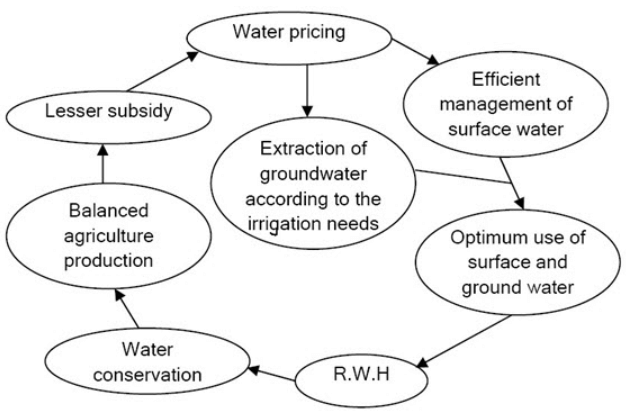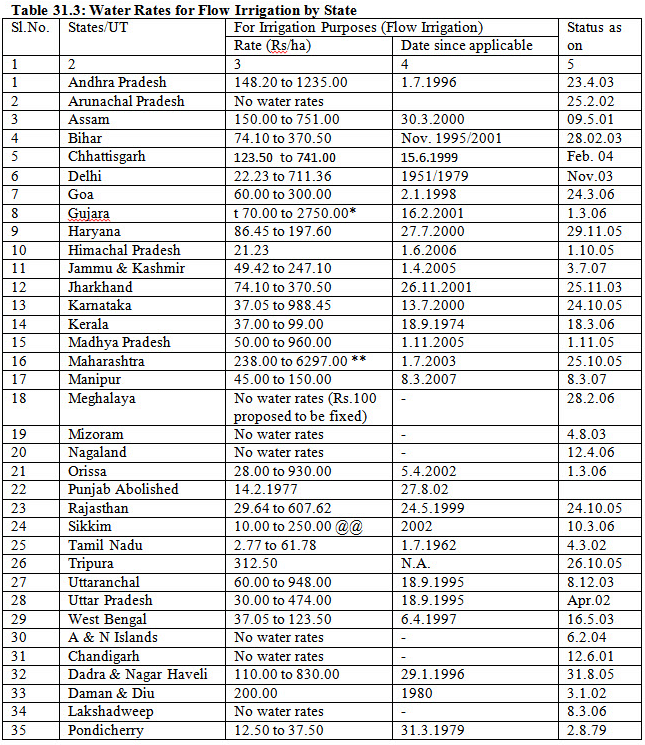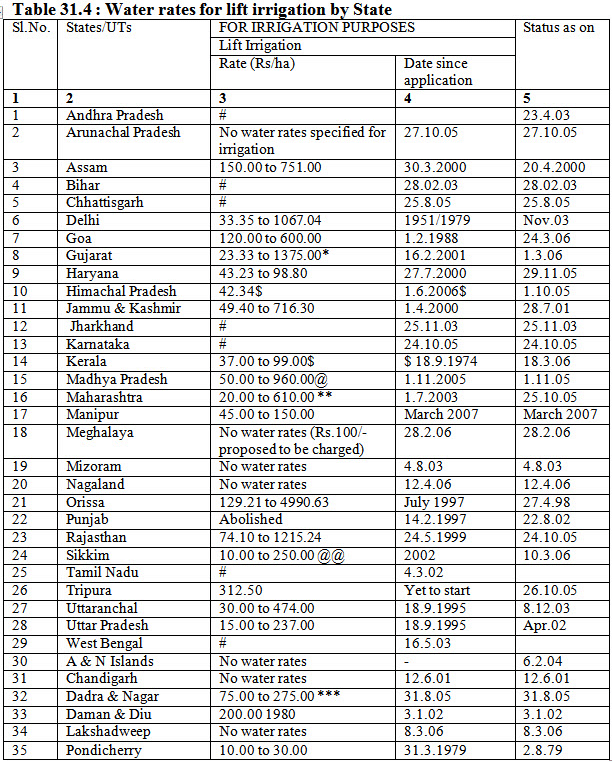Water Pricing, Mechanics of Tillage and Traction | Mechanics of Tillage and Traction Notes- Agricultural Engg - Agricultural Engineering PDF Download
Introduction
Economical use of water by effective and efficient water management in irrigation sector is imperative to cope up with the increasing population and developing agriculture technology. It is well understood that the water crisis emerging in India is not the result of natural factors, but has been caused by improper water resources management. It is argued that 50 per cent of India’s new water demand can be met by improving effectiveness of irrigation. There is growing concern that the area under irrigation has actually declined in recent years, and may continue to do so. Since agriculture is by far the largest user of water, efficient irrigation management will undoubtedly be a major conservation option for the future. For ensuring food security, irrigation system has to be made more effective. However, growing water scarcity is likely to pose a serious challenge to the needed expansion in food production.
The rate of return from irrigation projects has registered a progressive decline after independence. Instead of profit, there has been increasing losses, and this has imposed a growing burden on the revenues of the states. The Vaidyanathan Committee report (1992) pointed out that the irrigation commission did prescribe optimum levels of charges for use of water for irrigation as a percentage of gross income estimated to be around 5 per cent for food crops, and 12 per cent for cash crops. But the actual receipts vary from less than 1 per cent to a maximum of 2.9 per cent for all India. In fact for the state of Tamil Nadu, the percentage is as low as 0.1 per cent. While fuller utilisation of the irrigation potential and optimum irrigation from available supplies through good water management practices would make some improvement to the situation, the real and effective remedy seems to lie in the revision of the rates at which water is being supplied for irrigation purposes in India (Kartar Singh, 1978).
31.1 Existing water pricing method in India
In the golden age of Kings’ rule, the practice of water pricing is to collect portion of the produce from the farmers by the end of growing season and store them in the treasuries and use the same to feed the poor and meet the drought situation by the rulers. During the Mohuls’ rule and then during the British rule, the water rates were fixed and revenue was collected in the form of money. The water pricing policy in India is such that it does not even cover the cost of Operation and Maintenance (O&M) of the irrigation systems, let alone the full capital cost including O&M. This leads to severe financial pressure on the state since it has to absorb the subsidies. The water charge in India is based on per acre basis and does not vary with the volume of water actually used. According to the Constitution of India, irrigation is a subject under the State list. Irrigation projects are planned, executed, owned and operated by State Governments.
Irrigation projects are financed as a part of the National Development Programmes. These projects are financed by the State Governments out of their own revenues, market borrowings and loans and grants made available by the Central Government as a part of overall assistance for financing their plans. The State Governments have to repay the capital and interest charges for the loans taken by them from the Central government and the open market borrowings. There is also no uniformity as regards to principle considerations adopted by the states in fixing of water rates. Some of the important factors which are generally taken into consideration are Crop Water requirement, assuredness of supply of water, paying capacity of the farmers based on net or gross value of agricultural produce, cost of supply of water, recommendation of Irrigation Commission etc. But there is no uniformity or consistency as to how these factors are employed in fixation of rates by different States or Union Territories. This can be depicted with the help of the Table 31.1 which shows canal water rates for irrigation of major states of India and gives the water rates for canal irrigation in different states as reported in the CWC Publication “Pricing of Water in Public Systems in India”.
Table 31.1. Canal water rates for irrigation in major States
States | Rate (Rs./ha) | Few crops specific rates (Rs./ha) | Year in which rates revised last | |||
| Minimum | Maximum | Paddy | Wheat | Sugarcane |
|
Andhra Pradesh | 99 | 370 | 222 | - | 370 | 1986 |
Bihar | 30 | 158 | 89 | 51 | 158 | 1983 |
Gujarat | 40 | 830 | 110 | 110 | 830 | 1981 |
Haryana | 20 | 99 | 74 | 62 | 99 | 1975 |
Karnataka | 37 | 556 | 99 | 54 | 556 | 1985 |
Maharashtra | 100 | 1750 | 100 | 200 | 1750 | 1990 |
Madhya Pradesh | 99 | 741 | 198 | 24 | 741 | 1992 |
Orissa | 6 | 185 | 40 | 32 | 100 | 1981 |
Punjab | 14 | 82 | 49 | 29 | 82 | 1874 |
Rajasthan | 20 | 180 | 99 | 74 | 143 | 1982 |
Tamil Nadu | 6 | 64 | 49 | - | 49 | 1962 |
Uttar Pradesh | 15 | 410 | 143 | 143 | 237 | 1983 |
West Bengal | 37 | 134 | 37 | 49 | 124 | 1977 |
As can be noted from Table 31.1, there is great deal of variation in water rates from state to state which is presumably due to irrigation services in terms of its dependability and continuity. Pricing of canal waters is a state subject (like power) and hence tends to differ widely across states. With regard to the irrigation projects in the public sector, sale of water for irrigation constitutes the major portion of Gross Receipts for them. The various committees and Groups constituted for suggesting ways and means to improve financial performance of projects have recommended for restructuring of irrigation water rates.
There is considerable difference in the levying of water rates by different States and Union Territories. For example, no water rate is levied for agricultural purposes in most of the North-East States except for Manipur. In Orissa a flat basic compulsory water rate is charged for the staple crop Paddy in respect of lands coming under the command of Major and Medium Irrigation Projects. Except in Assam and the North Eastern States, all States charge, directly and indirectly for the use of irrigation water from public sources.
In West Bengal water is supplied only on prepayment basis as far as Minor Irrigation Schemes are concerned. In the Southern States of Andhra Pradesh, Karnataka, Tamil Nadu and Union Territory of Pondicherry where water rate and land revenue are inseparable. In these States lands are classified as 'Wet' and 'Dry' depending upon their getting or not getting water from a recognised public source. Wet and Dry lands are assessed differently for land revenue. Wet assessment is higher as compared to the Dry assessment and difference between the two is attributed to water rates. In the States which charge water rate for agricultural purposes, rates are in general levied on the basis of area irrigated except for the Tube well irrigation. But there is no uniformity as to how these two important factors are taken into account by States in fixing water rates. In some States special purpose cesses are also levied on irrigated area or crop over and above water rates. This system is in practice in States of Andhra Pradesh, Haryana, Karnataka, Kerala, Maharashtra, Tamil Nadu etc.
31.2 Importance of tank irrigation
In view of huge investment costs, long gestation period, heavy maintenance costs and ecological problems associated with major and medium irrigation projects, the importance of minor irrigation has been realized by all the concerned in the recent past. Among the minor irrigation projects, well irrigation is entirely private, centering on the individual farmers. On the other hand, tank irrigation has been traditionally a common property of a village and has played an important role in agricultural development; particularly in the semi-arid regions of the country. Further, tapping of ground water has become increasingly expensive on account of deeper and receding water table levels due to indiscriminate and unplanned expansion of well irrigation. Thus, there is a need to utilize the existing tanks by undertaking necessary repairs to them and evolving proper management systems. This will facilitate the optimum utilisation of the available rainwater for sustainable agricultural development in semi-arid tracts of the country. The success achieved by Japan, and more recently by China which planned their modernization programmes on traditional methods in the field of irrigation suggests the need to give due importance to the development of tank irrigation in our country, Tank modernization is the process by which the water in existing tanks is used more efficiently through improved water storage, distribution, and on-farm water use. The aim is to increase food production and rural incomes by achieving higher cropping intensity through improved water management and reduced water losses. Evaluation of Potential Returns from Modernization of Irrigation Tanks by implementing the modernization program, it is expected that more than 25% of the water will be saved. Past experiences from a pilot project (CWR, 1996) shows that by physical (hardware) modernization alone, irrigation efficiency was improved by 32.25% and subsequently yield increased by about 30% as presented table 31.2.
Table 31.2. Comparison of benefits before and after modernization of an Irrigation tank
Benefit | Before Modernization | After Modernization |
Conveyance efficiency (%) | 79.2 | 95.7 |
Distribution efficiency (%) | 50.0 | 90.0 |
Application efficiency (%) | 69.8 | 91.0 |
Irrigation efficiency (%) | 27.7 | 78.4 |
Water requirement (m3/ha) | 12300.0 | 10250.0 |
Paddy yield (t/ha ) | 3.0 | 3.9 |
Water Productivity (Rs/m3) | 0.2 | 0.3 |
Gross Income (Rs./ha) | 2962.0 | 5261.0 |
If such measures are extended to cover all other deteriorated tanks additional cropping area is certainly to be brought under cultivation, which will narrow down the gap between the potential and actual area irrigated by tanks. Catchment treatment in the tank area will not only contribute to increased availability of water supply, but also bring such environmental benefits as reduced sedimentation and increased ground water recharge. Nevertheless, unlike major irrigation structures, modernization of these small-scale irrigation structures will not have any negative impacts on the environment at the same time ensuring the stability and sustainability of crop production in the tank command areas
31.3 Benefits of water pricing
Water pricing for irrigation helps in the proper maintenance of the tanks. This can be shown with the help of the Fig.32.1. Water pricing is a good policy measure for the optimum use of water resource. Water pricing might influence the quantity of consumption of both surface and groundwater. Pricing of water allows the farmers to extract the quantity of water and power necessary to irrigate their land area.

Fig.31.1 Benefits of water pricing
Surface water pricing provide the sufficient fund for the proper maintenance of tanks and percolation ponds. These practices facilitate Rain Water Harvesting (RWH) and the conservation of water. The pricing of water selects the suitable crop for the particular type of land and availability of water. This will strengthen the attitude of farmers towards water pricing because of the fact that the optimum use of water will benefit the farmers by economizing the extraction cost and reliability in supply. This will change the negative attitude of the farmers towards water pricing.
31.4 Water pricing policy
In the developed countries like USA the exact requirements of water during the various stages of crops are taken into account for designing the necessary supply in the field channels. Information regarding rainfall, humidity, evaporation percolation etc., is utilized in arriving at the capacity of various channels in the distribution system. The cropping pattern is fixed to design the channel for the average duty. In all irrigation projects, the command area under the scheme generally lies on either side of the river or main canal. The canals mostly run on contour so as to cover the maximum possible area under them. After calculating the requirements of water for crops, the shutter of the sluice is opened automatically for a specific time for the command area below the sluice through remote control by the concerned Irrigation Engineer. During that specific time, the required water will flow over the field through branch channels or pipe outlets. The same system will be adopted for the other sluices also.
In India screw gearing shutters of the sluices are operated by the village assistants or president of the Water User Association. Thus the farmer has every control to use the precious resource either in a good manner or to waste it. The present practice of fixation of irrigation charges has several weaknesses. For example after the first irrigation is applied to a crop, the farmer has to pay the fixed amount of charges and thereafter, the marginal cost of second irrigation becomes zero. In such a situation the farmer may go on applying water up to the points where the marginal return is equal to zero. This leads farmers to use large quantities of water per hectare of each crop.
Pricing of water helps in reduction of wastage of water. Proper pricing can reduce the burden of the government. Most of the inefficiencies, misuse and environmental damage have their roots in the mispricing of water and electricity. Under the present practice of free electricity for agricultural purposes, the number of electric pumps tends to be more than the social optimum, resulting not only in the overexploitation of ground water, but also in the decline in collective management.
While all the countries have recognized the need and importance of charging appropriate fees for irrigation water supply, the creation and implementation of policies on irrigation water pricing are facing some problems. In most cases, the willingness and affordability of farmers to pay water charges are found to be very low as they have been receiving irrigation water free of charge. Therefore, greater efforts need to be targeted towards creating farmers' awareness and acceptance of the need to pay for irrigation water if they wish to receive the services on a sustained basis. For this they should be educated about the benefits from water pricing through forums like water users associations. The present rates of surface and lift irrigation for all the states of India are listed in Table 32.3 & 32.4 respectively.
Table 31.3 : Water Rates for Flow Irrigation by State



Remarks : * subject to increase @ 15% to 25% per annum
** subject to increase @ 15% per annum. The previous rates were Rs.20 - Rs.495 w.e.f. 1.9.2001
$ : These rates shall escalated by 10% on the first of April every year. The previous rates were Rs.13.96 to 82.15/ha w.e.f. 1977/1981
$$ : Proposed to be revised as Rs.250 - Rs.550/ha.
@ : The privious rates were Rs.123.50 to Rs.741.00 w.e.f. 15.6.1999
@@ : The rates as per the Sikkim irrigation water tax Act 2002 which is still in the process of enforcement. There were no water rates prior to this Act.
# : No separate rate for lift irrigation has been reported.
*** Depending upon the type of Minor Irrigation schemes, the date of enforcement varied from 1.12.1970 to 13.11.1973




















